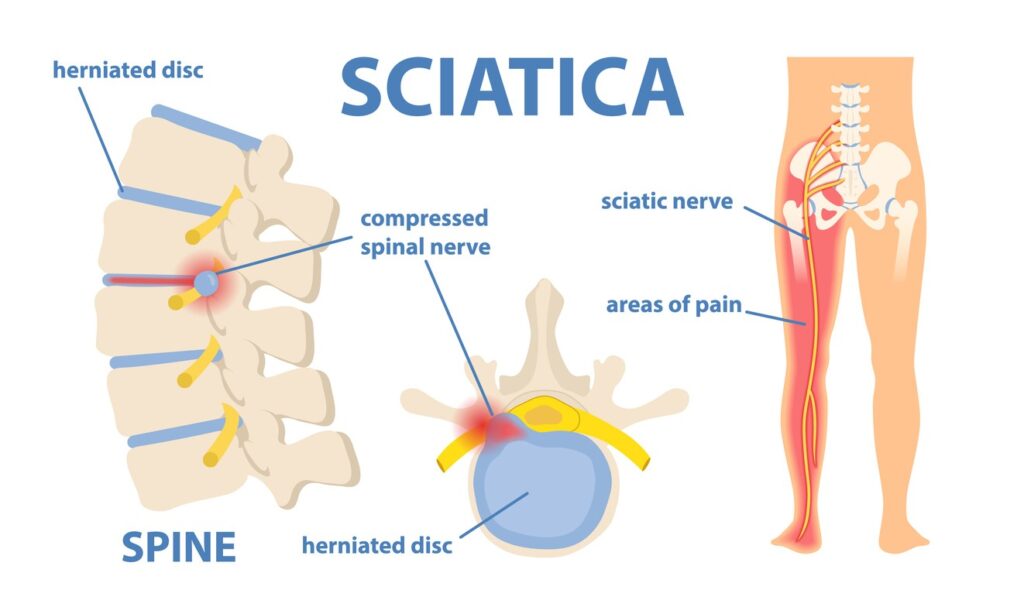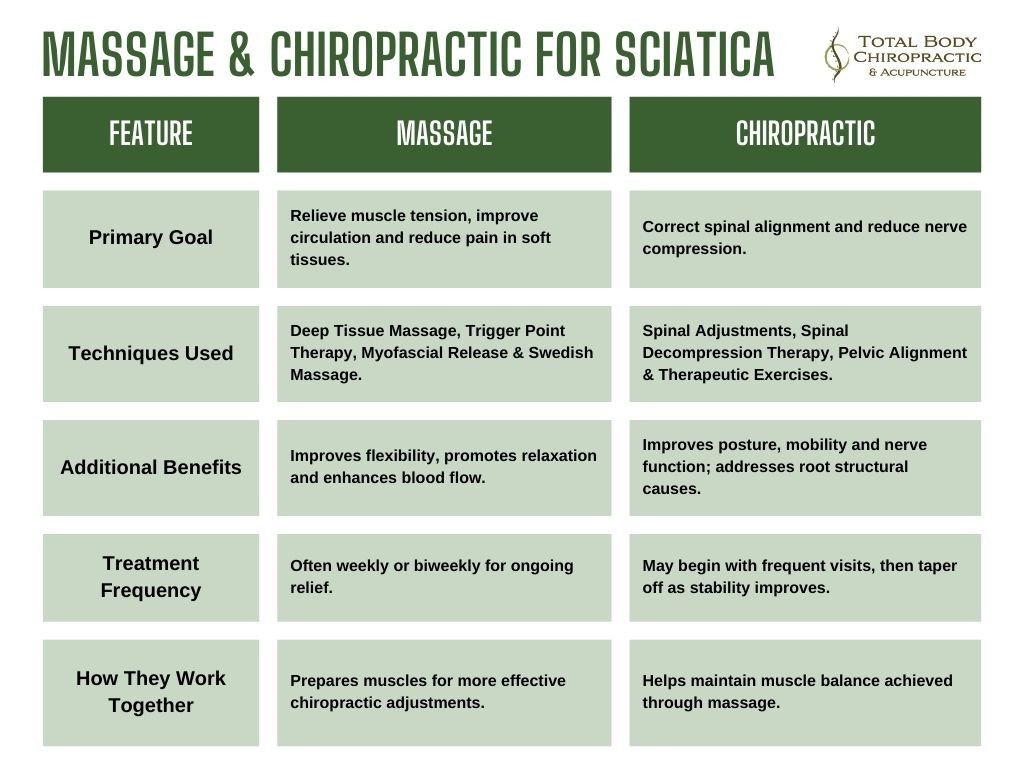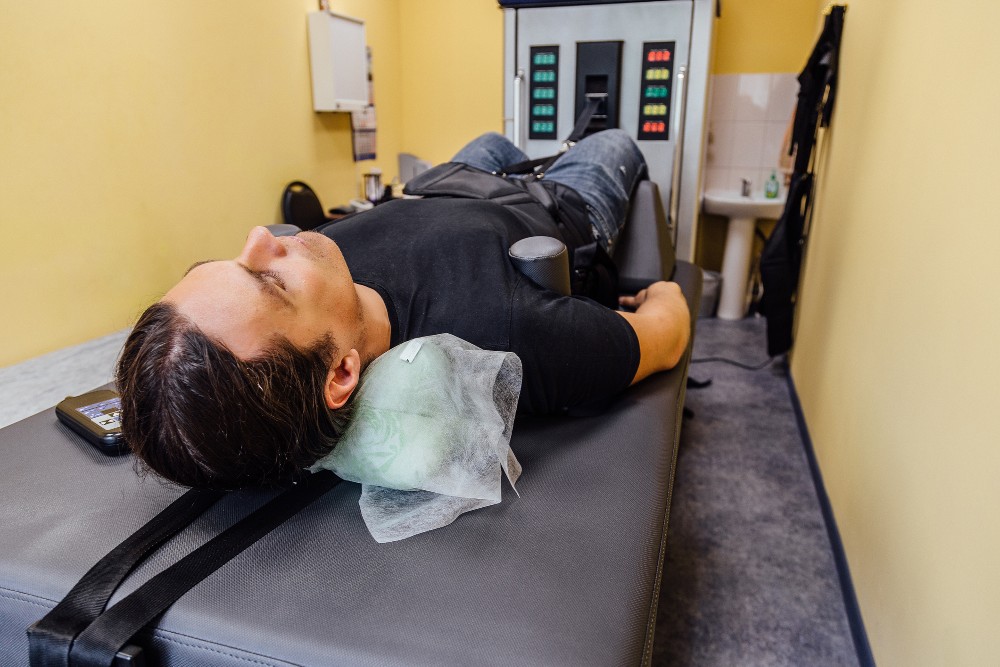How Massage Therapy Complements Chiropractic Care for Sciatica Relief
Living with Sciatica feels like carrying around an invisible weight that drags you down with every step that you take. The pain starts as a dull ache in your lower back but quickly travels through your hips, buttocks, and down your leg, or even all the way down to your foot. This isn’t just discomfort, it’s a disruption to your daily rhythm, your mobility, and even your sleep.
At Total Body Chiropractic in Bend, Oregon, we value how painful sciatica affects your daily life. That’s why our Bend chiropractors combine targeted spinal manipulations with therapeutic massage for sciatica pain, giving you a complete treatment plan that tackles both the cause and the symptoms for long-lasting relief.
What is Sciatica and Why Does it Happen?
Before you find out why it happens, it’s important to know that your sciatic nerve is the longest nerve in the entire human body, running from your lower back through your hips and all the way down each leg. When this nerve becomes compressed, inflamed, or irritated, it presents as a set of symptoms, collectively called “Sciatica”.
Sciatica symptoms move beyond pain: you might feel various sensations, tingling, numbness, or muscle weakness in your leg or foot. Long walks become more exhausting and painful, sitting for work feels totally unbearable, and daily activities that you loved doing once seem to be out of reach.

Common causes of sciatic nerve pain include:
- Herniated Disc: When the cushion-like disc between vertebrae bulges or ruptures, it presses on the nerve roots.
- Piriformis Syndrome: Tightness or spasms in the piriformis muscle can irritate the sciatic nerve.
- Spinal Stenosis: Narrowing of the spinal canal that crowds the nerve.
- Degenerative Disc Disease: Wear-and-tear changes in spinal discs can put pressure on nerves.
- Pelvic Misalignment or Poor Posture: Everyday habits can gradually lead to nerve compression.
Why a Combined Approach Works
Many patients typically try one therapy at a time, whether it’s chiropractic care or massage therapy, only to find the relief isn’t that effective in the long run. That’s because sciatica often involves structural issues and soft tissue problems such as muscle stiffness and inflammation. Entertaining only one side of the problem leaves the other side to cause the pain once again.
When they are used together, this holistic approach not only reduces sciatica pain; it addresses the underlying cause and prevent future flare-ups.

Here’s where our Bend chiropractors’ combined approach makes a significant difference:
- Chiropractic adjustments focus on restoring proper alignment of the spinal cord, reducing nerve compression, and improving joint mobility.
- Massage therapy targets tight muscles and fascia, improves circulation, and calms inflammation, creating the ideal environment for nerves to heal.
Think of it like this:
- Adjustments free up the nerve pathway so that your body can move naturally.
- Massage releases tension in the muscle around that pathway so that your adjustments hold longer and you stay free from pain for more time between visits.
This dual approach matches perfectly with our entire body-wellness philosophy, helping you feel better, move better, and live better, not just today, but in the months and years to come.
How Massage Therapy Complements Chiropractic Care for Sciatica Relief
What most people think about massage, they start imagining the relaxation, spa music, and maybe a scented candle or two. We agree that relaxation is a wonderful time to connect. Therapeutic massage for sciatica pain goes further; it’s a targeted hands-on approach to reduce muscle tightness in the affected area, improve blood flow, and help your body to heal.
Our professional massage therapists customize every session based on your symptoms, activity level, and recovery goals. There is no “one-size-fits-all” approach; your massage is as unique as your body type.
Massage Therapy’s Role in Sciatica Care
When the muscles around your hips, lower back, and glutes tighten up, they pinch and irritate the sciatic nerve. This tension then creates a cycle of lower back pain and inflammation that does not go away on its own. Massage therapy breaks it down by:
- Releasing tight muscles that contribute to nerve compression, especially in the piriformis and hamstrings.
- Improving flexibility and range of motion, making movement easier and less painful.
- Boosting circulation, which delivers oxygen and nutrients to injured tissues for faster healing.
- Reducing inflammation and muscle spasms that keep the nerve.

Massage Techniques for Sciatica
Here, the goal isn’t just to make you feel good and relaxed during the massage; it’s to create a muscle environment that supports lasting nerve health.
- Deep Tissue Massage: Works through multiple muscle layers to release chronic tension and adhesions.
- Trigger Point Therapy: Targets small, hyper-irritable spots in muscles that refer pain down the leg.
- Myofascial Release: Loosens the fascia (connective tissue) surrounding tense muscles, reducing stiffness.
- Sports Massage: Perfect for Bend’s active outdoor community, helping athletes recover from strain and maintain performance.
Chiropractic Techniques for Sciatica
While the massage addresses muscle tension, chiropractic care focuses more on perfecting the spinal alignment and restoring normal nerve function. Our Bend chiropractors use a wide range of techniques to make this process safe and effective, reducing sciatic nerve irritation.
Key methods include:
- Spinal Adjustments (Manual and Instrument-Assisted): These subtle but gentle movements realign the lumbar spine, taking the pressure off the sciatic nerve and improving your body’s natural range of motion.
- Spinal Decompression Therapy: Using a specialized table, the spine is gently stretched to create space between the vertebrae. This relieves pressure on compressed discs, reduces nerve irritation, and promotes nutrient-rich fluid flow for healing.
- Shockwave Therapy: Delivers high-energy acoustic waves to the affected area, stimulating blood flow, accelerating tissue repair, and breaking down scar tissue that may contribute to sciatic pain.
- Laser Therapy: Uses targeted light energy to penetrate deep into tissues, reducing inflammation, relieving pain, and supporting faster cellular healing in muscles and nerves.
- Pelvic Alignment Adjustments: Correct imbalances in your hips and pelvis that can lead to uneven weight distribution and nerve irritation.
- Therapeutic Exercises: Guided stretches and strengthening moves to support spinal health, improve posture, and reduce recurrence risk.
These techniques are made with keeping the patient’s comfort in mind. We avoid any aggressive, forceful movements and instead focus on more accurate, precise, and targeted body movements, which are optimal for you.
Also, once you combine the massage therapy and chiropractic adjustments, you will be getting double benefits. The muscle then relaxes, and so will the adjustment, making it much easier to hold longer, and the spine stays aligned, so the muscles don’t stiffen back there.
How the Two Therapies Work Together
Once you are scheduled for chiropractic care and massage for sciatica pain, you are not just getting two different treatments; you’re getting a full strategic plan for faster and more complete recovery.
Here’s how the combination works:
- Massage prepares your muscles by loosening the tight fibers, reducing inflammation, and improving the overall circulation. This means when you step into your chiropractic adjustment, your muscles are out of stress and now ready for a proper alignment.
- Adjustments help maintain muscle balance by keeping your spine and pelvis in the correct position. This stability helps the benefits of massage last a bit longer.
- Pain relief happens much faster because the structural and muscular causes of sciatica are addressed in accordance.
- Recovery speed improves since your body isn’t constantly fighting against unresolved tension or misalignment.

Imagine a runner setting out early on a crisp Bend morning. The pine-scented air is cool, the sun is just starting to light up the Cascade peaks, and the trail winds ahead in a perfect ribbon of dirt. But before long, each step sends a sharp, shooting pain from the lower back down the leg — the unwelcome grip of sciatica.
That’s where the combined power of massage and chiropractic care comes in.
- Loosen the Grip
A skilled massage therapist works into the tight glutes, hamstrings, and lower back muscles that have been locking down with every climb and descent. The tension melts away, circulation improves, and the body starts to feel light and ready again. - Restore the Alignment
With muscles relaxed, a chiropractic adjustment realigns the spine and pelvis, taking pressure off the sciatic nerve. The joints move freely, and the body feels balanced — like all the moving parts are finally working together again. - Back on the Trail
The combination doesn’t just ease pain in the moment — it speeds up recovery, keeps the benefits lasting longer, and reduces the chance of the same problem flaring up again. Before long, that same runner is back on the trail, stride smooth and strong, enjoying Bend’s sweeping views without a thought of sciatica.
What to Expect at Total Body Chiropractic
Your experience at our Bend clinic is designed to be professional and welcoming. We want you to feel confident and cared for every step of the way.

Here’s what you can expect:
- Comprehensive consultation: We assess your medical history, lifestyle, and symptoms to exactly pinpoint the cause of your sciatica.
- Collaborative care plan: Our chiropractors and massage therapists work closely to create a personalized strategy.
- A thorough communication: You’ll receive progress updates, at-home recommendations, and the ability to adjust your plan as needed.
- Focusing on the long-term results: Our goal isn’t just to get you out of pain; it’s to keep you there.
Sciatica Self-Care Between Visits
To keep your recovery moving forward, we recommend incorporating these habits into your routine. Start practicing.
Targeted stretches:
- Piriformis stretch to relieve muscle pressure on the nerve.
- Hamstring stretch to ease tension in the back of the leg.
- Hip flexor stretch to improve pelvic alignment.
Posture tips:
- Keep feet flat on the ground while sitting.
- Avoid prolonged leg crossing.
- Use a supportive chair or lumbar cushion.
Gentle activities:
- Low-impact exercises like swimming, walking, or yoga.
- Avoid high-impact sports until pain-free.
Nutrition & hydration:
- Stay hydrated to keep spinal discs healthy.
- Eat anti-inflammatory foods like berries, salmon, and leafy greens.
Lasting Relief Is Possible, Let’s Get Started
Living a life that is filled with pain and restricted by sciatica leaves you in uncertain conditions. By combining targeted chiropractic adjustments with the complementary therapy of massage, our Bend chiropractors can set you free from the pain and get you back to the healthy lifestyle you loved.
At Bend Total Body Chiropractic, we believe in restoring your mobility, preventing any future flare-ups, and helping you feel your absolute best so that you can move freely and confidently without any hesitation every single day.
Time to book your appointment and work together to make your sciatic pain a thing of the past, because you deserve a life that is far and free from pain and stress.


















